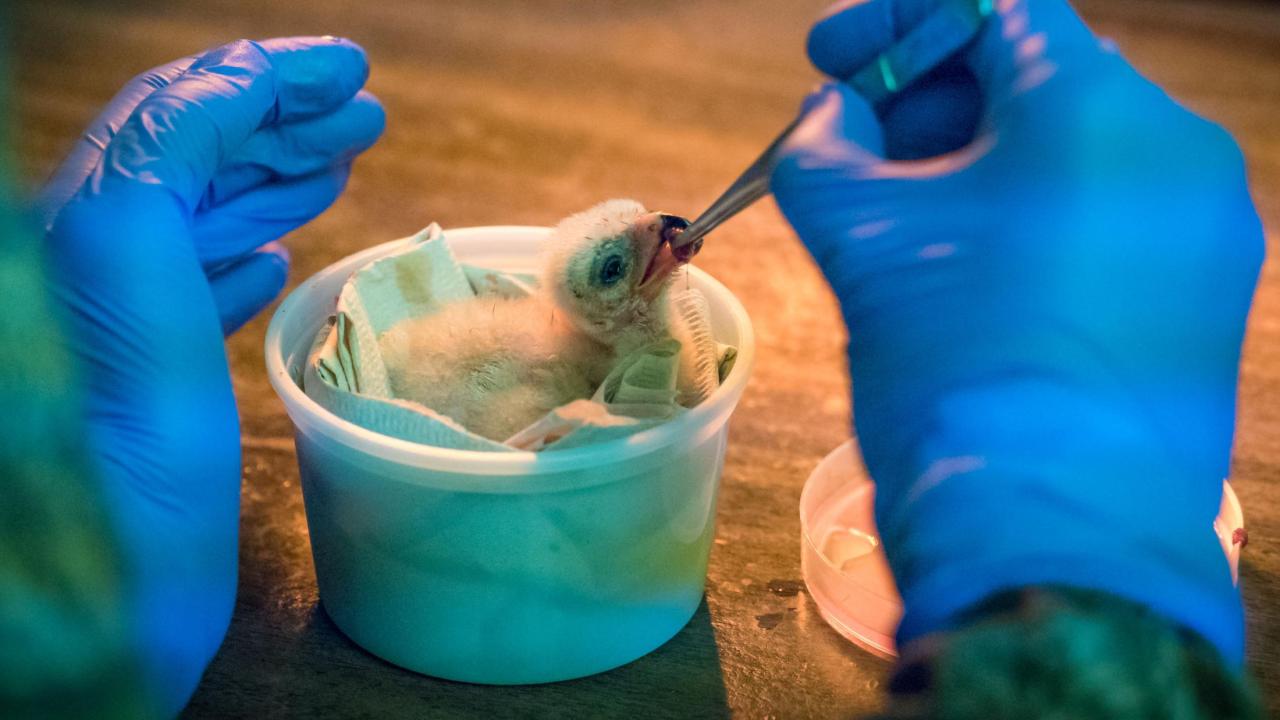
Raising Raptors: California Raptor Center's Nursery
Raising raptor chicks in the raptor nursery begins with rescuing orphaned chicks from dangerous situations
(Please see "Rescue: Is this Baby Really an Orphan?”)
Steps to Raising Raptors “Inside the Nursery”
Brooder: Newly hatched chicks (“hatchlings”) are placed in insulated plastic boxes called brooders where the downy chicks are maintained at an even, warm temperature and humidity, under controlled lighting and reduced sound.
Feeding: The hatchlings must be fed multiple times throughout the day with fresh bits of whole prey to assure good bone and muscle development. Caretakers wear camouflage and use a puppet and tweezers during feeding so babies won’t associate food with humans.
Imprinting: All birds, when they are very young, begin to identify with whatever is feeding and caring for them. This process is called “imprinting.” In the wild, baby birds learn their identity and social behavior from parent birds and nest-mates. All nursery activities must be carefully controlled; even hearing human voices can improperly imprint some raptors, especially owlets.
Brooder Time: The youngsters are kept in the brooder until they are several weeks old. Their down is then thick enough to cover their bodies; their necks are strong enough to hold up the weight of the head and their wings and legs are sturdy enough to keep them from falling over.
Nest Boxes: When the baby raptors are reliably picking up bits of mouse left in front of them, they can be moved into larger nest boxes lined with soft materials. Here they remain until they are able to eat whole prey. If the chick is a single orphan, we often put a toy baby raptor in the nest for the youngster to see.
Chamber: After the chicks can move about freely and can thermoregulate (adjust to ambient temperatures), they are placed in a large chamber with other birds, often with a foster parent or visual surrogate, an adult of the same or similar species who is tolerant of youngsters. This helps the young birds continue to identify with their own kind and to sharpen their vital social skills.
Flight Cage/Hack Box: As the young birds grow, they begin to flap and hop. We then move them into larger housing so they can continue to move and gain strength. From there, after we band them with a numbered metal anklet from the US Fish and Wildlife Service, we move them into a final enclosure.
Barn Owls: Barn Owls and single youngsters go into flight cages from which they can in time be taken to an outdoor release area.
Other Raptors: Groups of other raptors go into a “hack box,” an airy, enclosed cage high in a tree, where we can feed them for a week or so until they associate the box with food. Then we open the box and let the youngsters fledge. They return to the box for the food we leave on top. As they become skilled in flight and hunting, they return less frequently for food.
Dispersal: The final step is dispersal. In time, the young birds fly farther afield in search of good hunting and safe roosts. In this way, we prepare young raptors to go out into the world and become self-sufficient.
Thank you to Sallie Reynolds for the original text of this article and Lis Fleming for her edits and updates.

